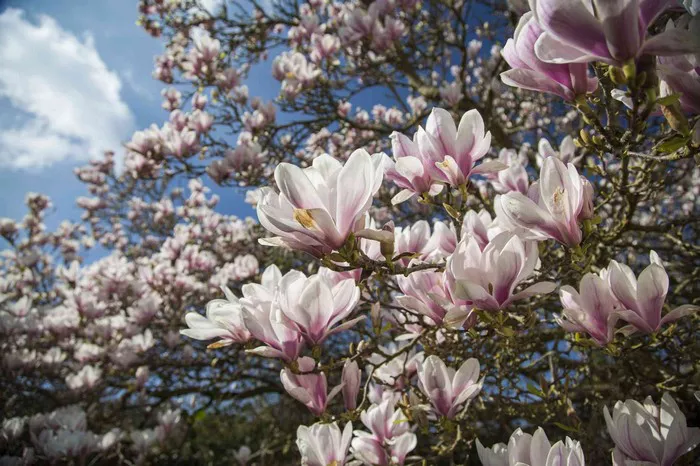Magnolia flowers, with their captivating allure and timeless elegance, have long been celebrated for their exquisite beauty. These blossoms, belonging to the genus Magnolia, encompass a diverse array of species and cultivars, each possessing its own unique charm and characteristics. From the delicate petals to the intoxicating fragrance, magnolia flowers captivate the senses and inspire admiration among botanists, horticulturists, and nature enthusiasts alike.
The Botanical Marvel of Magnolia Flowers
Magnolia flowers are renowned for their distinctive appearance, which sets them apart from other flowering plants. These exquisite blooms typically feature large, showy petals that form elegant, cup-shaped blossoms. The petals often exhibit a range of colors, including shades of white, pink, purple, and yellow, adding to their visual appeal.
One of the defining characteristics of magnolia flowers is their robust and fleshy petals, which lend them a sense of durability and substance. Unlike the delicate petals of some other flowers, magnolia petals have a substantial texture that contributes to their longevity and resilience.
In addition to their striking appearance, magnolia flowers are also prized for their enchanting fragrance. Many species and cultivars of magnolias emit a sweet, citrusy scent that perfumes the air and attracts pollinators such as bees and butterflies. This aromatic allure adds another layer of allure to these already captivating blossoms.
Varieties of Magnolia Flowers
The genus Magnolia encompasses a diverse range of species and cultivars, each with its own unique characteristics and attributes. Some of the most popular varieties of magnolia flowers include:
1. Magnolia grandiflora: Also known as the Southern magnolia, this species is revered for its large, fragrant flowers and glossy evergreen foliage. The blossoms of Magnolia grandiflora can reach up to 12 inches in diameter and boast a creamy white hue with a subtle hint of lemon.
2. Magnolia stellata: Commonly referred to as the star magnolia, this species produces elegant, star-shaped flowers with delicate, strap-like petals. The blossoms of Magnolia stellata typically emerge in early spring, heralding the arrival of the new season with their ethereal beauty.
3. Magnolia liliiflora: Also known as the lily magnolia or the tulip tree, this species is prized for its striking, goblet-shaped flowers and compact growth habit. The blossoms of Magnolia liliiflora feature rich shades of pink and purple, adding a vibrant splash of color to the landscape.
4. Magnolia soulangeana: This hybrid magnolia, a cross between Magnolia liliiflora and Magnolia denudata, is cherished for its profusion of large, tulip-shaped flowers and vigorous growth habit. The blossoms of Magnolia soulangeana range in color from white to pink to purple, creating a breathtaking display in the springtime.
These are just a few examples of the many magnificent magnolia species and cultivars that grace gardens, parks, and landscapes around the world. Each variety offers its own unique blend of beauty, fragrance, and charm, making magnolia flowers a beloved favorite among gardeners and flower enthusiasts.
Cultural Significance of Magnolia Flowers
In addition to their botanical allure, magnolia flowers hold special cultural significance in many societies around the world. These blossoms have been revered for centuries for their beauty, symbolism, and therapeutic properties.
In some cultures, magnolia flowers are associated with purity, femininity, and grace, symbolizing qualities such as love, beauty, and nobility. In traditional Chinese medicine, magnolia blossoms are valued for their medicinal properties and are used to treat various ailments, including anxiety, stress, and respiratory issues.
Magnolia flowers also hold a prominent place in literature, art, and folklore, where they are often depicted as symbols of beauty, resilience, and the fleeting nature of life. From ancient myths and legends to modern poetry and paintings, magnolia flowers continue to inspire creativity and imagination across cultures and generations.
Growing and Caring for Magnolia Flowers
While magnolia flowers are renowned for their beauty and resilience, they do require specific growing conditions and care to thrive. Here are some tips for cultivating and caring for magnolia flowers:
1. Choose the Right Location: Magnolia trees prefer well-drained soil and a location with full to partial sunlight. Select a site that offers protection from strong winds and extreme temperatures.
2. Provide Adequate Watering: Keep the soil evenly moist, especially during periods of drought or hot weather. Avoid overwatering, as excessive moisture can lead to root rot and other problems.
3. Fertilize Regularly: Feed magnolia trees with a balanced, slow-release fertilizer in the spring to promote healthy growth and abundant flowering.
4. Prune Carefully: Prune magnolia trees as needed to remove dead or diseased branches and promote a tidy, attractive appearance. Avoid excessive pruning, as this can reduce flowering and stress the tree.
5. Protect from Pests and Diseases: Keep an eye out for common pests and diseases that can affect magnolia trees, such as scale insects, aphids, and fungal infections. Treat any problems promptly to prevent them from spreading.
By following these guidelines and providing the proper care, you can enjoy the beauty and splendor of magnolia flowers in your own garden or landscape for years to come.
Conclusion
Magnolia flowers, with their captivating beauty and timeless appeal, continue to enchant and inspire people around the world. From their exquisite petals to their intoxicating fragrance, magnolia blossoms embody the essence of elegance, grace, and resilience. Whether adorning gardens, parks, or landscapes, magnolia flowers leave an indelible impression on all who encounter them, reminding us of the enduring power and beauty of nature.


